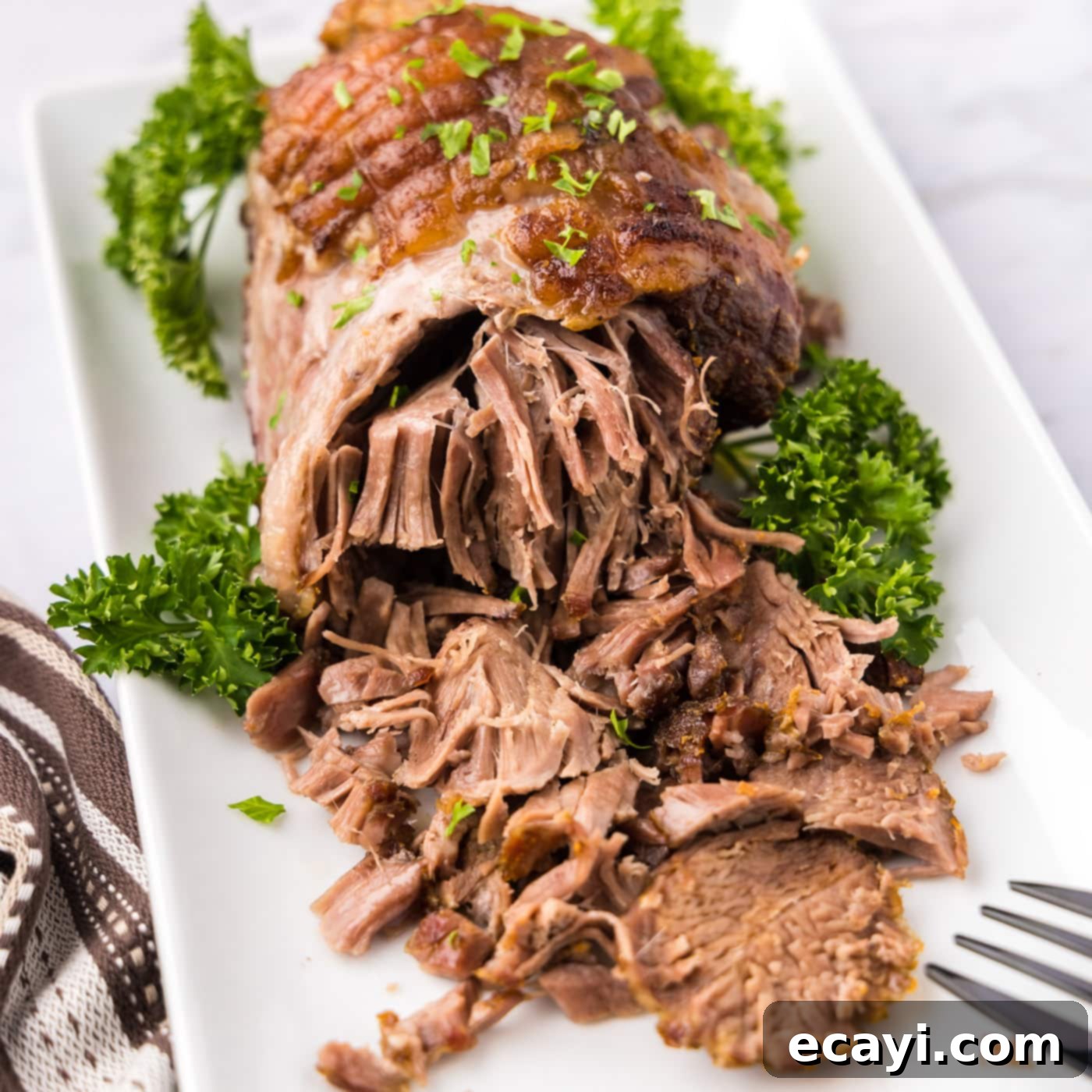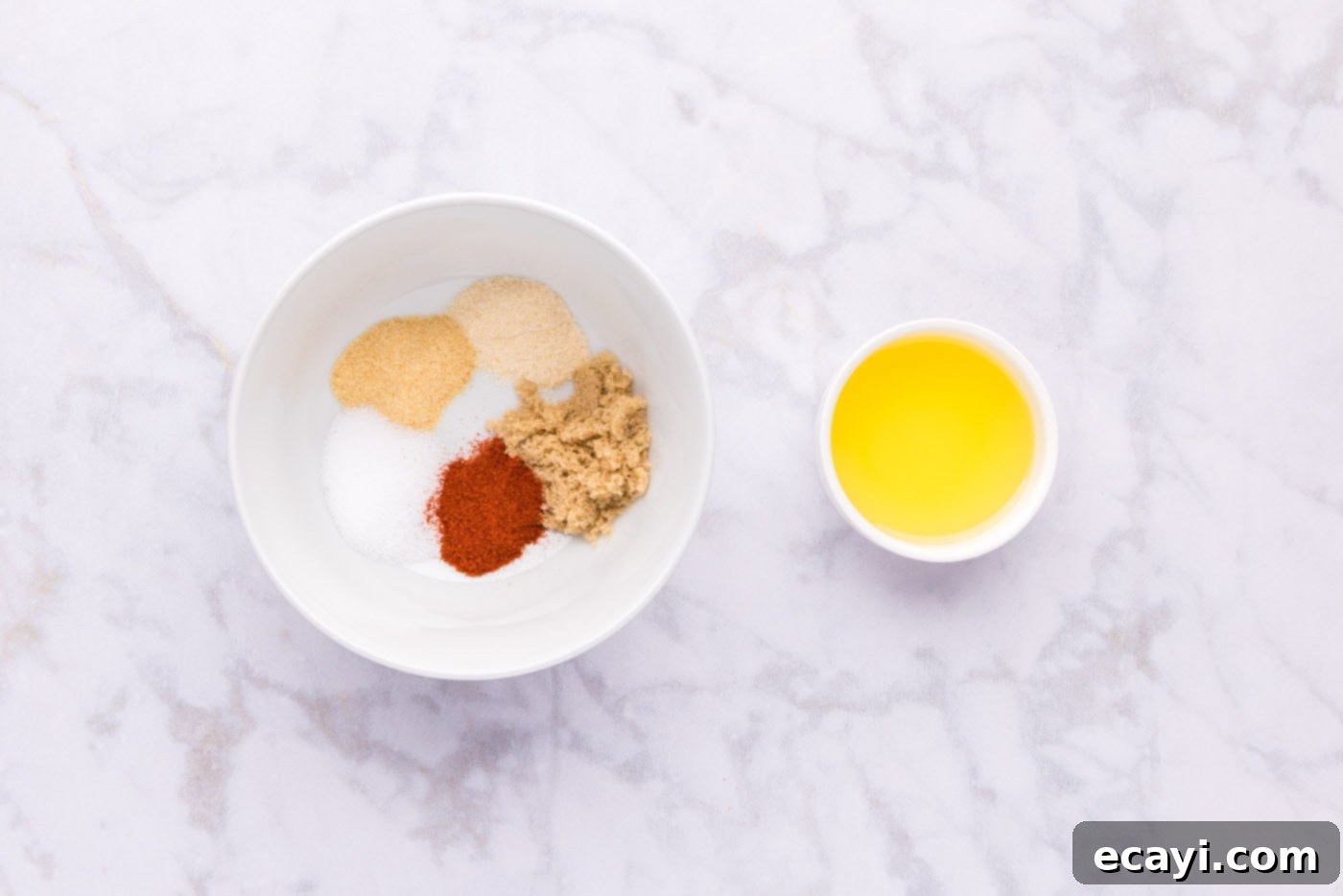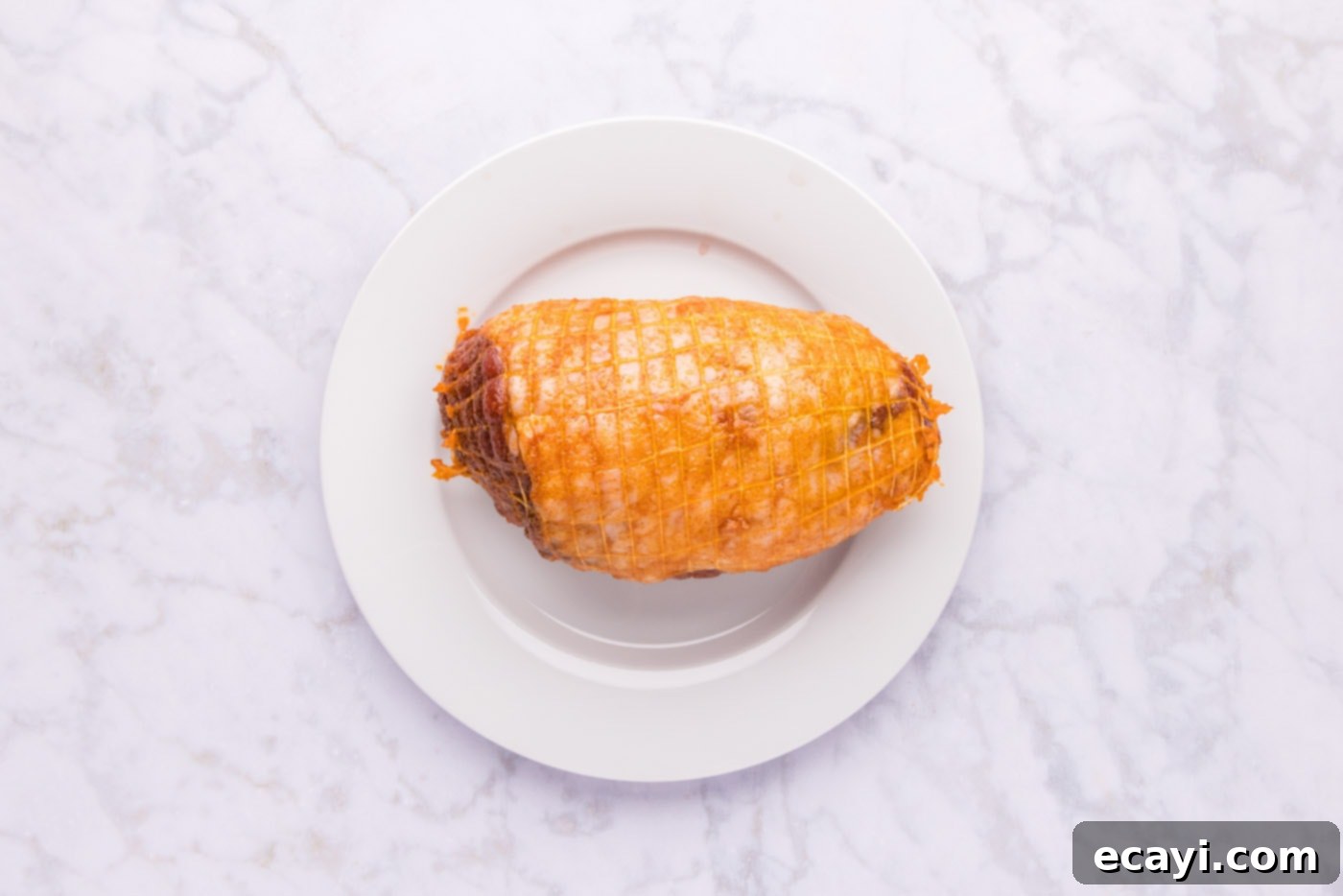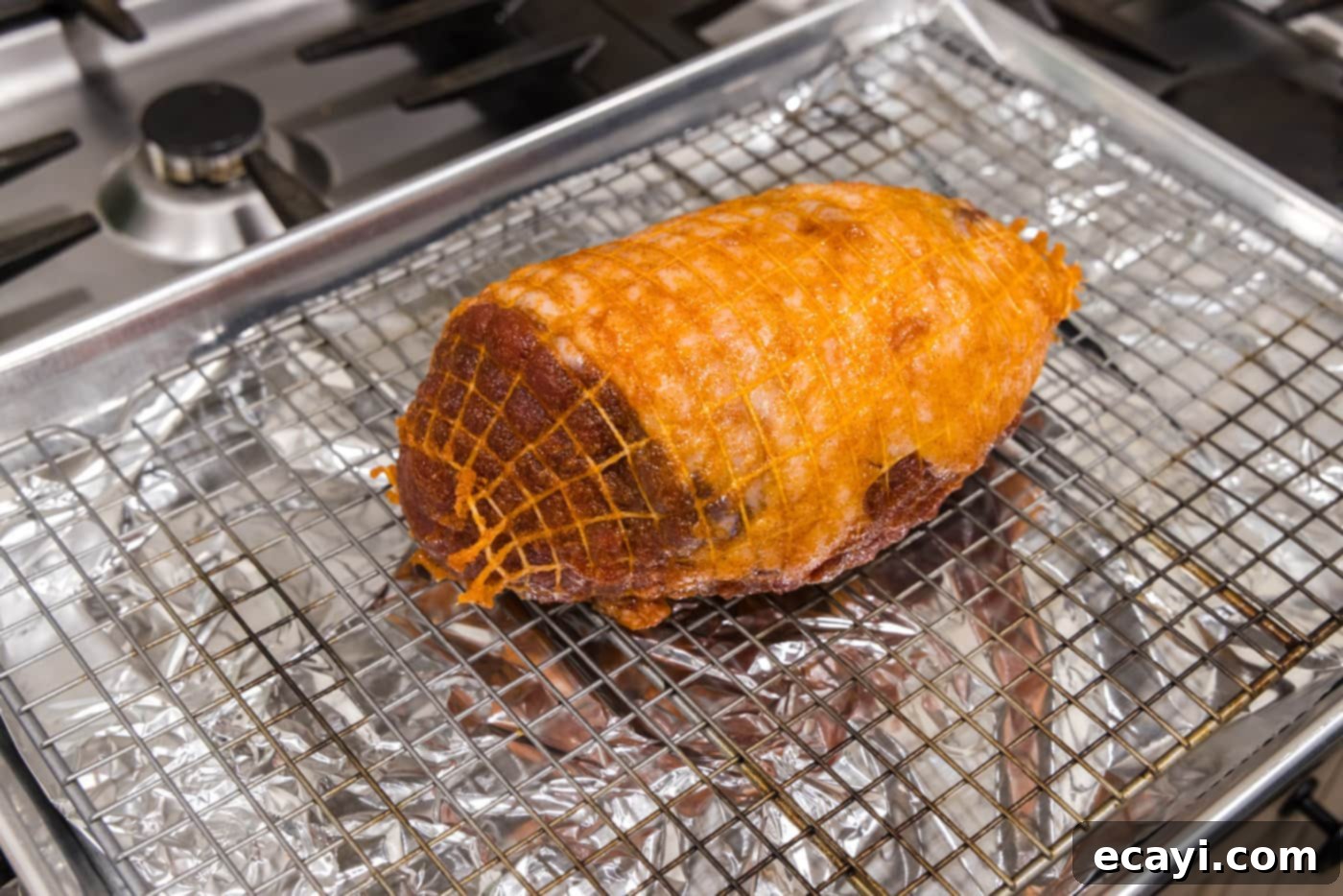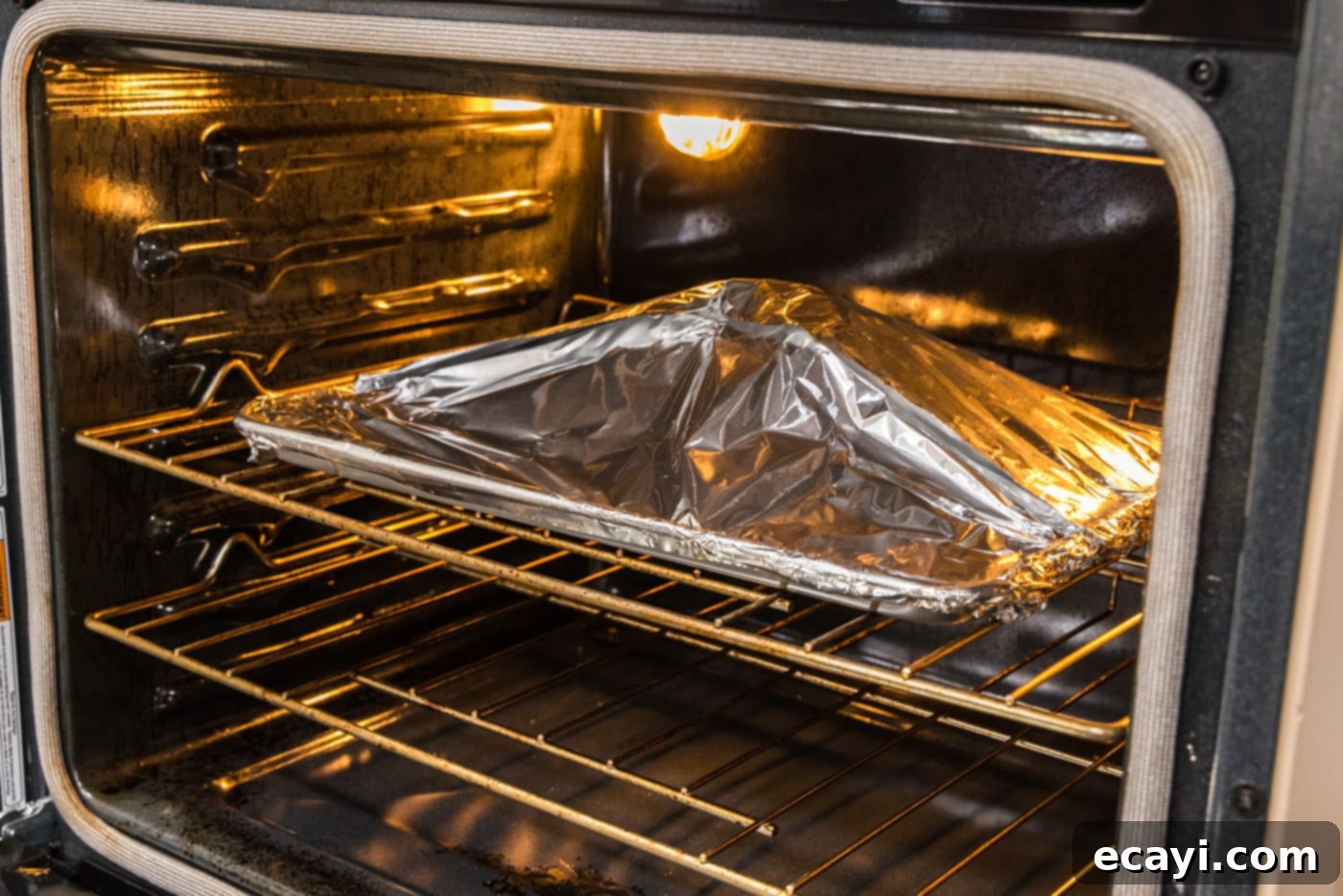Slow Roasted Leg of Lamb: Effortlessly Tender & Flavorful for Your Next Special Occasion
A beautifully tender, pull-apart leg of lamb is the ultimate showstopper for any holiday gathering or special occasion dinner. While it looks incredibly impressive, the truth is, achieving this succulent masterpiece is far easier than you might imagine. This slow-roasted lamb recipe promises a dish so moist and flavorful, it practically melts in your mouth, making you look like a culinary genius with minimal effort.
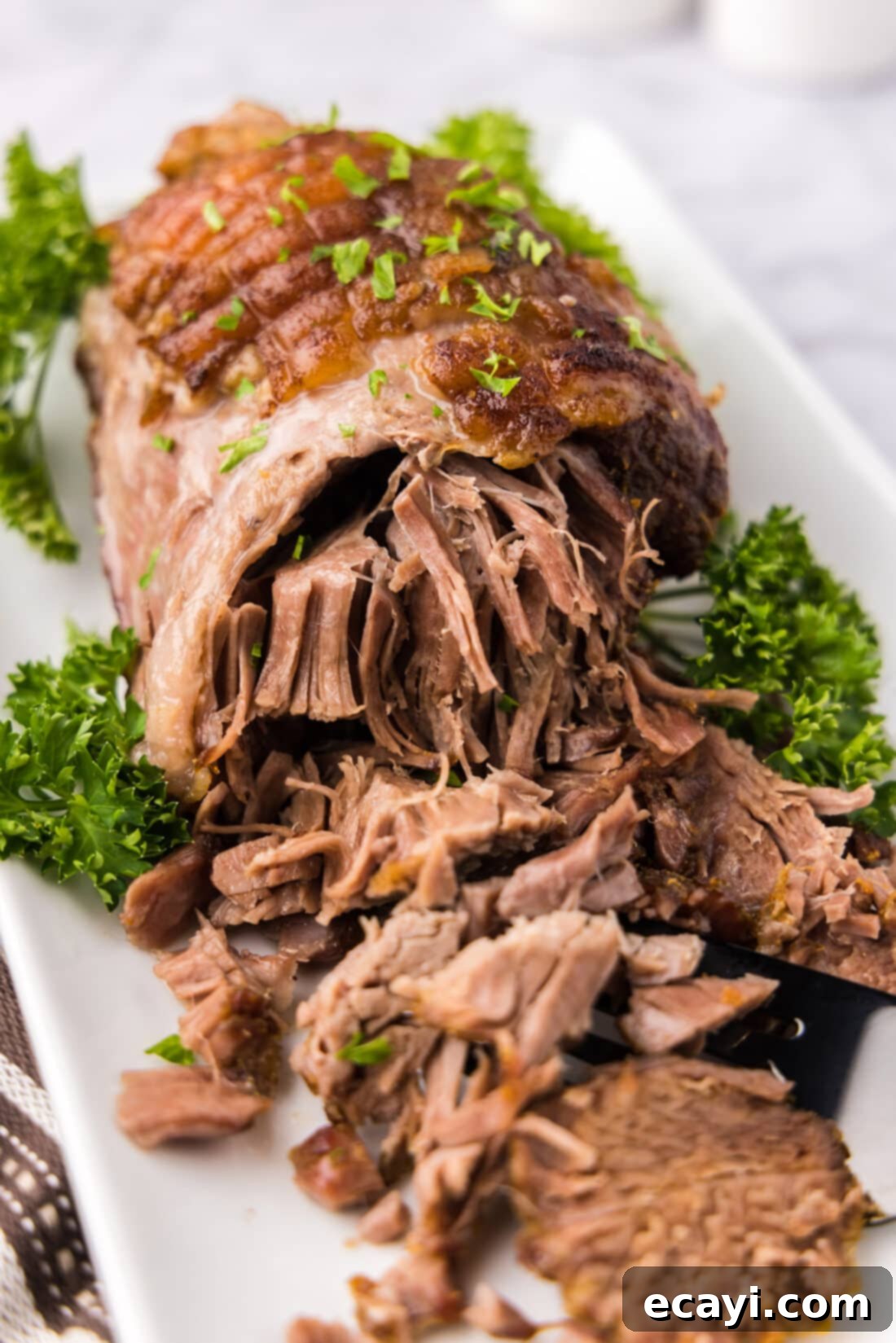
Why This Slow-Roasted Leg of Lamb Recipe Works So Well
This juicy leg of lamb recipe is meticulously crafted to be the highlight of your grand holiday dinner. We embrace simplicity, allowing the inherent richness of the lamb to shine through. The secret lies in a straightforward yet incredibly effective wet rub: a harmonious blend of smoked paprika, garlic powder, onion powder, a touch of brown sugar, and salt, all emulsified with olive oil. This rub doesn’t just season; it creates a beautiful crust while infusing the meat with aromatic depth without overpowering its natural flavor.
The beauty of this method is its ease: simply mix the rub, generously coat the lamb, and let your oven do the rest. After approximately 3.5 to 4 hours of slow roasting, you’ll be rewarded with an impossibly tender, flavorful lamb leg that’s ready to be pulled apart with a fork. The leg of a lamb is a well-exerted cut, meaning it benefits immensely from slow, gentle heat. This process breaks down connective tissues, transforming what could be a tough cut into a buttery-soft delight. Unlike quicker cooking methods suitable for cuts like lamb loin chops, slow roasting is key to unlocking the leg’s full potential for tenderness. Trust us, some culinary delights are worth the wait, and this incredibly tender slow-roasted leg of lamb is undoubtedly one of them.
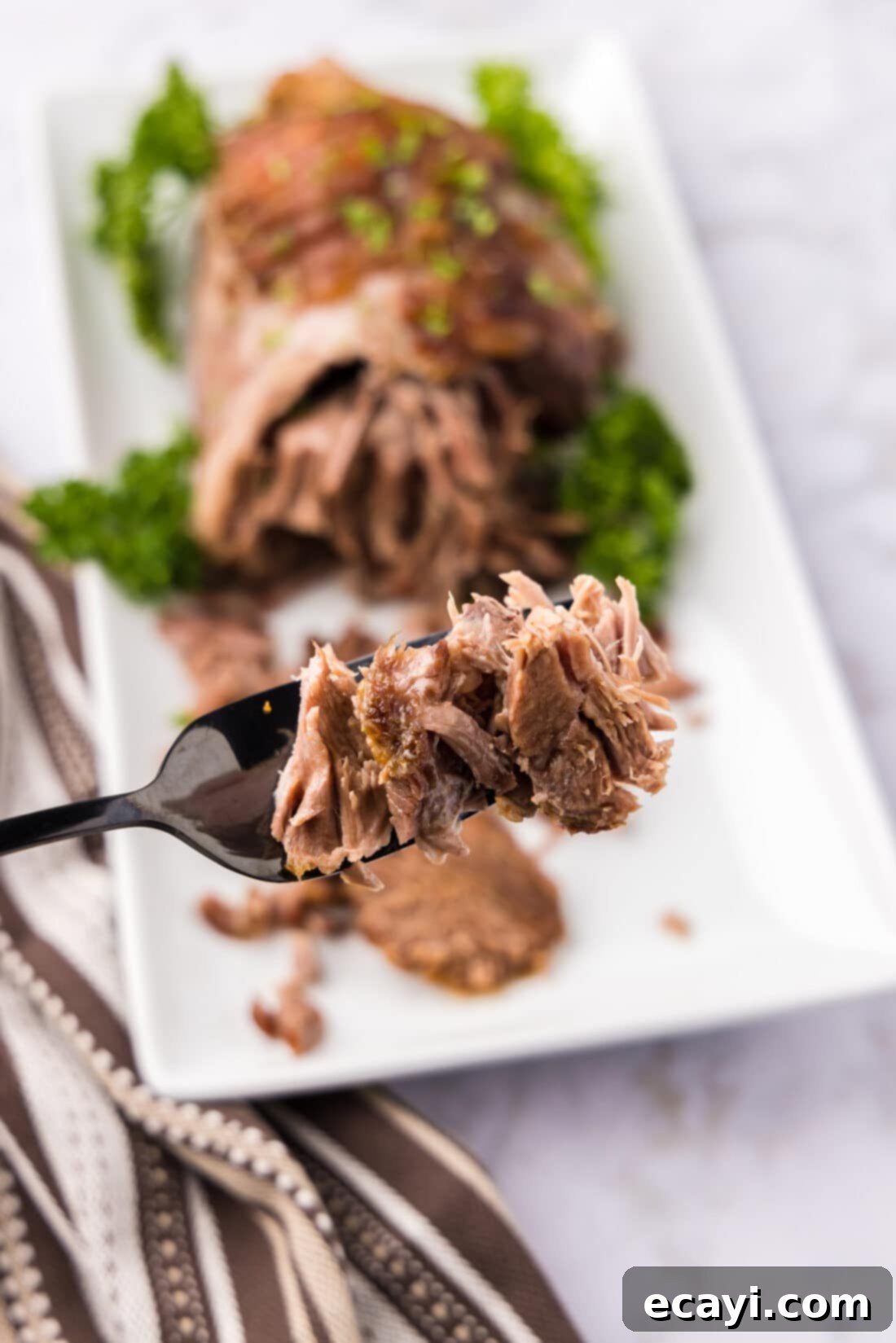
Key Ingredients for Your Tender Leg of Lamb Roast
Crafting the perfect slow-roasted leg of lamb requires just a handful of quality ingredients. Below, you’ll find the essentials to get started. For precise measurements and step-by-step instructions, be sure to grab the printable version of this recipe conveniently located at the end of this post.
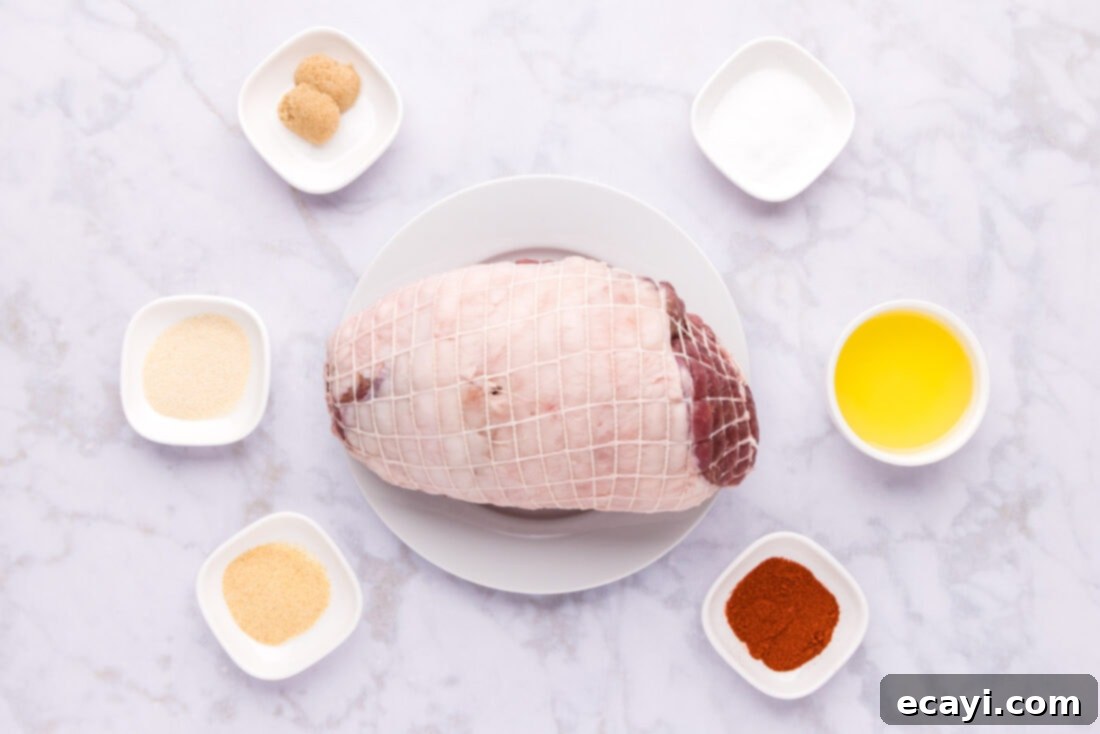
Ingredient Spotlight: Tips for Selecting & Customizing Your Lamb Roast
LAMB – The star of our dish is, of course, the leg of lamb. You can typically find boneless or bone-in leg of lamb roasts readily available at the meat counter of most well-stocked grocery stores or local butcher shops. We opted for a boneless leg of lamb roast in this recipe, primarily for its ease of carving and consistent cooking. However, bone-in lamb can be used if preferred, as the bone often imparts additional flavor and moisture during the slow roasting process. If you choose a bone-in cut, don’t hesitate to ask your butcher to trim any excess fat for you; a good butcher can save you time and ensure a cleaner roast.
Boneless leg of lamb roasts often come wrapped in a netting. This netting is crucial as it helps the deboned meat maintain its shape and cook evenly. Most commercial netting is oven-safe, but it’s always wise to double-check the packaging for confirmation before placing it in the oven. If your netting isn’t oven-safe or if you prefer a natural alternative, you can easily tie the roast with butcher’s twine to achieve the same effect. Look for lamb with a deep red color and a small amount of marbling for optimal flavor and tenderness.
SEASONINGS – Our simple yet potent wet rub is a symphony of flavors designed to complement the lamb’s natural taste. Smoked paprika lends a subtle, earthy smokiness, while garlic powder and onion powder provide a foundational aromatic depth. Brown sugar contributes to a beautiful caramelized crust and balances the savory notes, and salt enhances all the other flavors. These ingredients are combined with olive oil to create a paste that adheres perfectly to the meat. This blend is wonderfully versatile, and you’re encouraged to adjust it to your personal taste. For an added layer of freshness and herbal complexity, consider incorporating finely chopped fresh rosemary, thyme, or oregano. A pinch of black pepper or a touch of dried mustard can also elevate the flavor profile, giving your tender lamb roast a unique twist.
How to Prepare Your Perfectly Tender Leg of Lamb
These step-by-step photos and detailed instructions are provided to help you visualize each stage of making this incredible recipe. For a convenient printable version, complete with all measurements and instructions, you can Jump to Recipe at the bottom of this post.
- Preheat your oven to 325°F (160°C). This lower temperature is essential for slow roasting, ensuring the lamb cooks gently and evenly, resulting in maximum tenderness.
- In a small bowl, combine the smoked paprika, garlic powder, onion powder, brown sugar, and salt with the olive oil. Mix thoroughly until a smooth, wet paste forms. Wear vinyl gloves for easy application and to keep your hands clean. Generously rub this aromatic paste all over the entire surface of the lamb roast, ensuring every crevice is coated for maximum flavor infusion.


- Prepare your roasting pan by lining a baking sheet with heavy-duty foil. This makes cleanup significantly easier. Place a wire rack directly over the foil-lined baking sheet. The rack is crucial as it elevates the lamb, allowing for even heat circulation and preventing the bottom from steaming.
- Carefully place the seasoned leg of lamb roast onto the wire rack. Then, wrap the entire pan tightly with another sheet of foil, creating a sealed environment. This foil tent helps to trap moisture and steam, ensuring the lamb remains incredibly juicy and tender throughout the long cooking process.

- Transfer the wrapped roasting pan to your preheated oven and bake for 3.5 to 4 hours. The exact cooking time can vary slightly depending on your oven and the thickness of the lamb. The goal is a fork-tender roast that can be easily pulled apart.

- Once the lamb is cooked to perfection, remove it from the oven. **It is vital to allow the roast to rest.** Do not remove the foil during this period. Let it rest, still covered, for 20-30 minutes. This resting time allows the juices within the meat to redistribute, ensuring every slice is as moist and flavorful as possible. After resting, carefully unwrap, carve (or pull apart!), and serve.
Frequently Asked Questions & Expert Tips for Perfect Lamb
Proper storage is key to enjoying your delicious leftovers. Once your leg of lamb has cooled completely, transfer any remaining meat to an airtight container. It can be safely stored in the refrigerator for up to 3 days. To reheat, place the lamb in a 350°F (175°C) oven until it is warmed through, adding a splash of broth or water to keep it moist. Leftovers can also be frozen for up to 3 months; simply thaw in the refrigerator before reheating.
Marinating is a common practice for many cuts of lamb, but for this specific slow-roasted leg of lamb recipe, it’s not an absolutely essential step. Our carefully crafted wet rub provides ample flavor and moisture, especially with the long, gentle cooking process. This saves you valuable prep time. However, if you’re a fan of deeply infused flavors, you can certainly give your lamb a little bath in a lamb chop marinade. Just be mindful not to over-marinate; 15-45 minutes is usually plenty to impart flavor without altering the meat’s texture too much for a roast of this size.
For a pull-apart tender leg of lamb, we are aiming for well-done, which is an internal temperature of around 190-200°F (88-93°C). While this might seem high compared to standard roasts, for “pull-apart” texture, this extended cooking time is necessary to break down connective tissues. If you prefer a less “fall-off-the-bone” texture but still tender:
- Medium-Rare: 130-135°F (54-57°C)
- Medium: 135-140°F (57-60°C)
- Medium-Well: 140-150°F (60-66°C)
- Well-Done (Pull Apart): 190-200°F (88-93°C)
Always use a reliable meat thermometer inserted into the thickest part of the meat, avoiding the bone.
Absolutely! Adding vegetables to the pan can enhance the flavor of your lamb and create a convenient one-pan meal. Root vegetables like carrots, potatoes, onions, and parsnips work wonderfully. Simply chop them into large chunks, toss them with a little olive oil, salt, and pepper, and add them to the pan during the last 1.5 to 2 hours of roasting. They will absorb the delicious lamb drippings and become beautifully tender.
Resting the meat is a critical step that often gets overlooked, but it’s essential for a truly juicy roast. When meat cooks, its muscle fibers contract, pushing the juices towards the center. If you cut into the lamb immediately after removing it from the oven, those juices will simply run out onto your cutting board, leaving you with drier meat. Resting allows the muscle fibers to relax and reabsorb those delicious juices, ensuring every piece of your slow-roasted lamb remains moist and flavorful. Don’t skip this step!
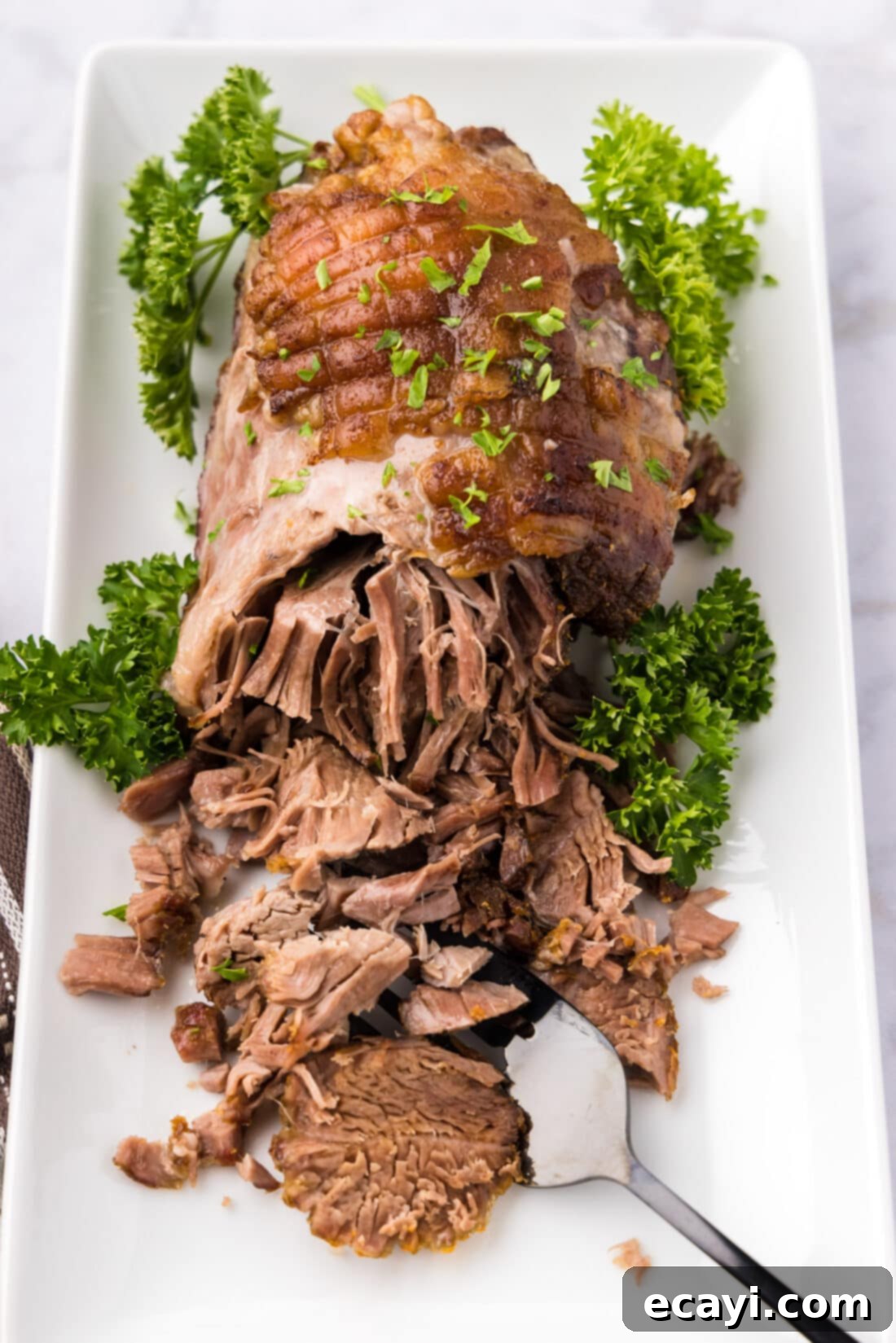
Delectable Serving Suggestions for Your Lamb Roast
This magnificent leg of lamb roast deserves to be paired with equally delightful side dishes. Classic accompaniments include creamy mashed potatoes, providing a comforting contrast to the rich lamb, or crispy roasted potatoes that beautifully soak up the pan drippings. For a well-rounded meal, consider serving a medley of roasted vegetables such as vibrant carrots, crisp asparagus, tender green beans, or savory Brussels sprouts. Each offers unique textures and flavors that complement the lamb perfectly.
To elevate your dining experience further, prepare a simple gravy using the flavorful pan drippings collected during roasting. Simply thicken the drippings with a little flour or cornstarch slurry, and season to taste. This lamb also pairs exceptionally well with unique sides like sweet and airy carrot souffle or the rich, comforting notes of sweet potato souffle. For a touch of brightness, a dollop of fresh mint sauce or a zesty chimichurri can cut through the richness of the lamb beautifully. No matter how you choose to serve it, this tender leg of lamb promises a memorable and satisfying meal. Enjoy every exquisite bite!
Explore More Delicious Lamb Recipes
If you’ve enjoyed this delightful lamb roast and are eager to explore more ways to cook lamb, check out some of our other fantastic recipes:
- Perfectly Seared Lamb Chops
- Flavorful Lamb Meatballs
- Quick & Easy Broiled Lamb Chops
- Crispy Pan-Fried Lamb Chops
I love to bake and cook and share my kitchen experience with all of you! Remembering to come back each day can be tough, that’s why I offer a convenient newsletter every time a new recipe posts. Simply subscribe and start receiving your free daily recipes!
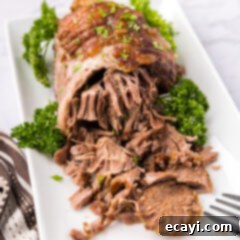
Leg of Lamb
IMPORTANT – There are often Frequently Asked Questions within the blog post that you may find helpful. Simply scroll back up to read them!
Print It
Pin It
Rate It
Save ItSaved!
Ingredients
- 2 ½ pound boneless leg of lamb roast
- ½ teaspoon smoked paprika
- 1 teaspoon garlic powder
- 1 teaspoon onion powder
- 2 teaspoons brown sugar
- 1 teaspoon salt
- 1 ½ Tablespoons olive oil
Things You’ll Need
-
Baking sheet
-
Wire cooling rack
-
Vinyl gloves
Before You Begin
- You can find lamb leg roast at most grocery stores at the meat counter. We chose boneless lamb leg roast, but you can use bone-in if you prefer.
- Boneless leg of lamb roasts will come wrapped in netting, which is typically oven safe but always check to make sure before putting it in the oven. The netting holds the deboned meat in place as it cooks. You can wrap it with butchers twine if your netting is not oven-safe.
Instructions
-
Preheat oven to 325 F.
-
Combine all of the seasonings with the olive oil in a small bowl to form a wet paste. Rub the paste all over the meat.
-
Line a baking sheet with foil. Place a wire rack over the foil lined baking sheet.
-
Place the seasoned roast onto the wire rack and wrap the pan tightly with foil.
-
Place in the oven and bake for 3 1/2 – 4 hours.
-
Remove from the oven and allow to rest, do not remove foil, for 20-30 minutes.
Expert Tips & FAQs
- Store any cooled leftovers in an air tight container kept in the refrigerator for up to 3 days. Reheat in a 350F oven until warmed through.
Nutrition
The recipes on this blog are tested with a conventional gas oven and gas stovetop. It’s important to note that some ovens, especially as they age, can cook and bake inconsistently. Using an inexpensive oven thermometer can assure you that your oven is truly heating to the proper temperature. If you use a toaster oven or countertop oven, please keep in mind that they may not distribute heat the same as a conventional full sized oven and you may need to adjust your cooking/baking times. In the case of recipes made with a pressure cooker, air fryer, slow cooker, or other appliance, a link to the appliances we use is listed within each respective recipe. For baking recipes where measurements are given by weight, please note that results may not be the same if cups are used instead, and we can’t guarantee success with that method.
